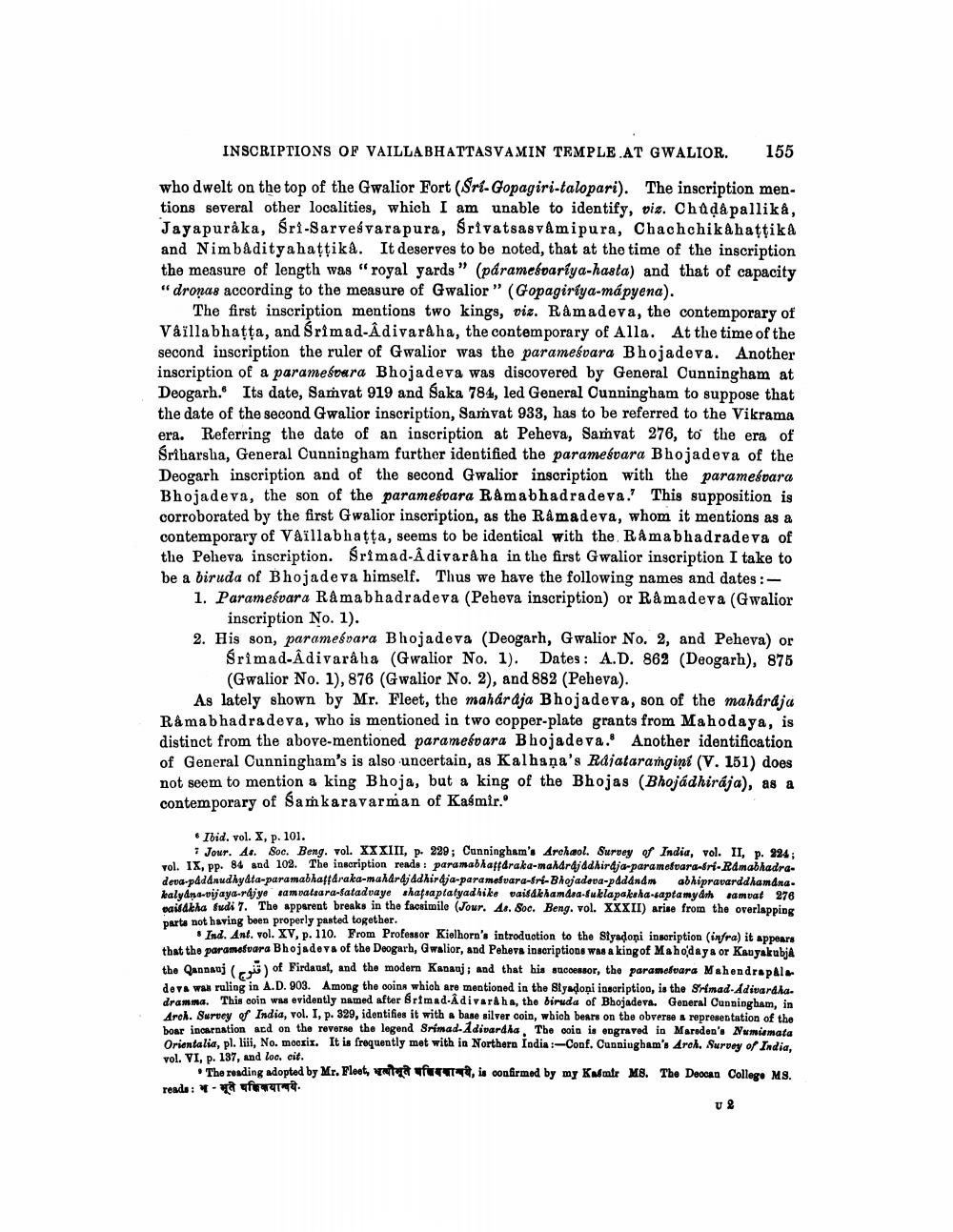________________
INSCRIPTIONS OF VAILLABHATTASVAMIN TEMPLE AT GWALIOR.
155
who dwelt on the top of the Gwalior Fort (Sri-Gopagiri-talopari). The inscription men. tions several other localities, which I am unable to identify, viz. Chaḍâpallika, Jayapuraka, Sri-Sarvesvarapura, Srivatsasvámipura, Chachchik&hattika and Nimbâdityahaṭṭika. It deserves to be noted, that at the time of the inscription the measure of length was "royal yards" (páramesvariya-hasta) and that of capacity "dronas according to the measure of Gwalior" (Gopagiriya-mápyena).
The first inscription mentions two kings, viz. Ramadeva, the contemporary of Vâïllabhaṭṭa, and Srimad-Âdivarâha, the contemporary of Alla. At the time of the second inscription the ruler of Gwalior was the parameśvara Bhojadeva. Another inscription of a parameswara Bhojadeva was discovered by General Cunningham at Deogarh. Its date, Samvat 919 and Saka 784, led General Cunningham to suppose that the date of the second Gwalior inscription, Samvat 933, has to be referred to the Vikrama era. Referring the date of an inscription at Peheva, Samvat 276, to the era of Śriharsha, General Cunningham further identified the parameśvara Bhojadeva of the Deogarh inscription and of the second Gwalior inscription with the paramesvara Bhojadeva, the son of the paramesvara Râmabhadradeva. This supposition is corroborated by the first Gwalior inscription, as the Ramadeva, whom it mentions as a contemporary of Vaïllabhaṭṭa, seems to be identical with the Ramabhadradeva of the Peheva inscription. Srimad-Adivarâ ha in the first Gwalior inscription I take to be a biruda of Bhojadeva himself. Thus we have the following names and dates:
1. Paramesvara Râmabhadradeva (Peheva inscription) or Ramadeva (Gwalior inscription No. 1).
2. His son, parameśvara Bhojadeva (Deogarh, Gwalior No. 2, and Peheva) or Srimad-Adivarâha (Gwalior No. 1). Dates: A.D. 862 (Deogarh), 875 (Gwalior No. 1), 876 (Gwalior No. 2), and 882 (Peheva).
As lately shown by Mr. Fleet, the mabárdja Bhojadeva, son of the malárája Råmabhadradeva, who is mentioned in two copper-plate grants from Mahodaya, is distinct from the above-mentioned parameśvara Bhojadeva. Another identification of General Cunningham's is also uncertain, as Kalhana's Raiatarangini (V. 151) does not seem to mention a king Bhoja, but a king of the Bhojas (Bhojádhirája), as a contemporary of Samkaravarman of Kasmir.
Ibid. vol. X, p. 101.
Jour. As. Soc. Beng. vol. XXXIII, p. 229; Cunningham's Archaol. Survey of India, vol. II, p. 224; vol. IX, pp. 84 and 102. The inscription reads: paramabhaffaraka-maharajadhiraja-parametvara-sri-Ramabhadradeva-pådánudhyata-paramabhattaraka-maharajadhiraja-paramesvara-sri-Bhojadeva-padánám abhipravarddhamana. kalyana-vijaya-rajye samvatsara-satadvaye shatsaptatyadhike vaisakhamasa-suklapaksha-saptamyam samvat 276 vaisakha sudi 7. The apparent breaks in the facsimile (Jour. As. Soc. Beng. vol. XXXII) arise from the overlapping parts not having been properly pasted together.
Ind. Ant. vol. XV, p. 110. From Professor Kielhorn's introduction to the Styadoni inscription (infra) it appears that the parameswara Bhojadeva of the Deogarh, Gwalior, and Peheva inscriptions was a king of Mahodaya or Kanyakubja the Qannauj () of Firdaust, and the modern Kanauj; and that his successor, the parametvara Mahendrapala deva was ruling in A.D. 903. Among the coins which are mentioned in the Siyadoni inscription, is the Srimad-Adivardha dramma. This coin was evidently named after Srimad-Adivaraha, the biruda of Bhojadeva. General Cunningham, in Arch. Survey of India, vol. I, p. 329, identifies it with a base silver coin, which bears on the obverse a representation of the boar incarnation and on the reverse the legend Srimad-Adivardha, The coin is engraved in Marsden's Numismata Orientalia, pl. liii, No. mooxix. It is frequently met with in Northern India:-Conf. Cunningham's Arch. Survey of India, vol. VI, p. 137, and loc. cit.
The reading adopted by Mr. Fleet, wat
far, is confirmed by my Kasmir M8. The Deocan College MS.
reads : भू भूते पञ्चिकयान्वये.
U 2




